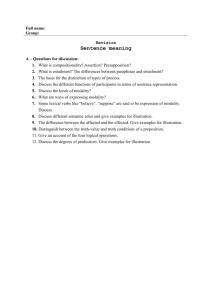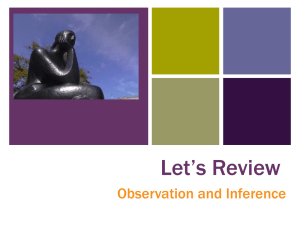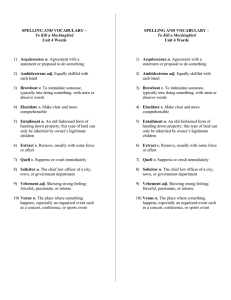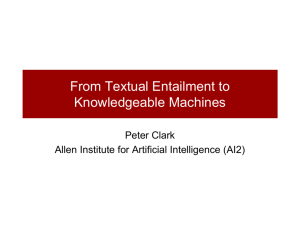PROBABILISTIC TEXTUAL ENTAILMENT: GENERIC APPLIED
advertisement
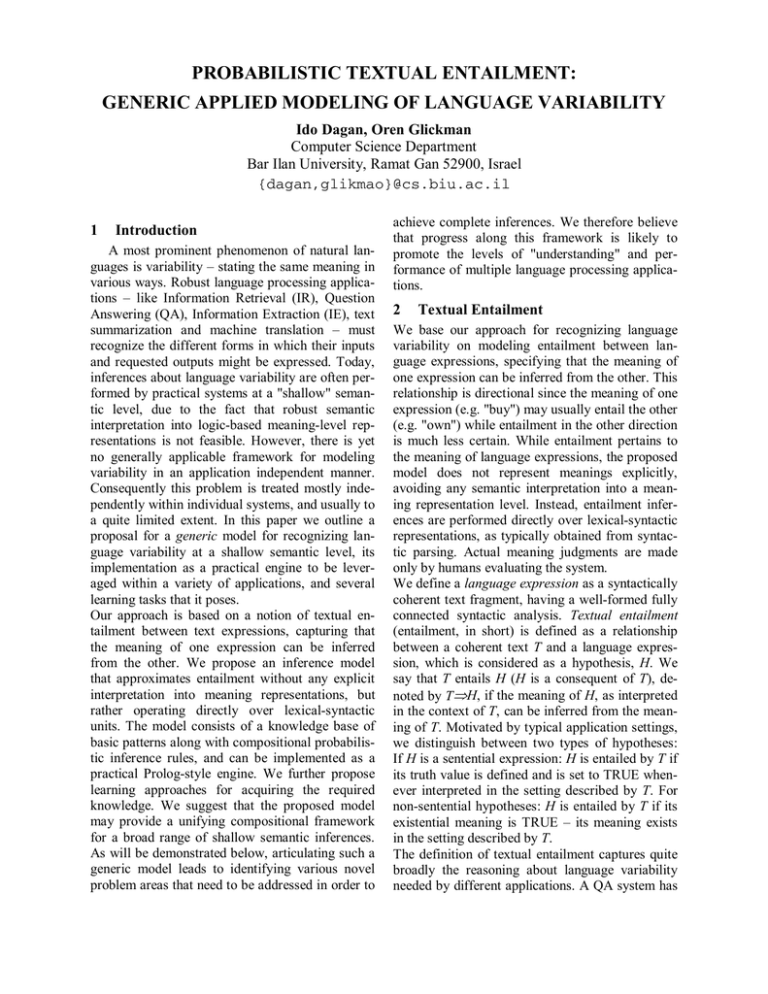
PROBABILISTIC TEXTUAL ENTAILMENT:
GENERIC APPLIED MODELING OF LANGUAGE VARIABILITY
Ido Dagan, Oren Glickman
Computer Science Department
Bar Ilan University, Ramat Gan 52900, Israel
{dagan,glikmao}@cs.biu.ac.il
1
Introduction
A most prominent phenomenon of natural languages is variability – stating the same meaning in
various ways. Robust language processing applications – like Information Retrieval (IR), Question
Answering (QA), Information Extraction (IE), text
summarization and machine translation – must
recognize the different forms in which their inputs
and requested outputs might be expressed. Today,
inferences about language variability are often performed by practical systems at a "shallow" semantic level, due to the fact that robust semantic
interpretation into logic-based meaning-level representations is not feasible. However, there is yet
no generally applicable framework for modeling
variability in an application independent manner.
Consequently this problem is treated mostly independently within individual systems, and usually to
a quite limited extent. In this paper we outline a
proposal for a generic model for recognizing language variability at a shallow semantic level, its
implementation as a practical engine to be leveraged within a variety of applications, and several
learning tasks that it poses.
Our approach is based on a notion of textual entailment between text expressions, capturing that
the meaning of one expression can be inferred
from the other. We propose an inference model
that approximates entailment without any explicit
interpretation into meaning representations, but
rather operating directly over lexical-syntactic
units. The model consists of a knowledge base of
basic patterns along with compositional probabilistic inference rules, and can be implemented as a
practical Prolog-style engine. We further propose
learning approaches for acquiring the required
knowledge. We suggest that the proposed model
may provide a unifying compositional framework
for a broad range of shallow semantic inferences.
As will be demonstrated below, articulating such a
generic model leads to identifying various novel
problem areas that need to be addressed in order to
achieve complete inferences. We therefore believe
that progress along this framework is likely to
promote the levels of "understanding" and performance of multiple language processing applications.
2
Textual Entailment
We base our approach for recognizing language
variability on modeling entailment between language expressions, specifying that the meaning of
one expression can be inferred from the other. This
relationship is directional since the meaning of one
expression (e.g. "buy") may usually entail the other
(e.g. "own") while entailment in the other direction
is much less certain. While entailment pertains to
the meaning of language expressions, the proposed
model does not represent meanings explicitly,
avoiding any semantic interpretation into a meaning representation level. Instead, entailment inferences are performed directly over lexical-syntactic
representations, as typically obtained from syntactic parsing. Actual meaning judgments are made
only by humans evaluating the system.
We define a language expression as a syntactically
coherent text fragment, having a well-formed fully
connected syntactic analysis. Textual entailment
(entailment, in short) is defined as a relationship
between a coherent text T and a language expression, which is considered as a hypothesis, H. We
say that T entails H (H is a consequent of T), denoted by T⇒H, if the meaning of H, as interpreted
in the context of T, can be inferred from the meaning of T. Motivated by typical application settings,
we distinguish between two types of hypotheses:
If H is a sentential expression: H is entailed by T if
its truth value is defined and is set to TRUE whenever interpreted in the setting described by T. For
non-sentential hypotheses: H is entailed by T if its
existential meaning is TRUE – its meaning exists
in the setting described by T.
The definition of textual entailment captures quite
broadly the reasoning about language variability
needed by different applications. A QA system has
1. Axiom rule:
EP
P (T1 →
T2 ) = max{entailment patterns EP matching T1 ,T2 } P ( EP holds for T1 , T2 )
2. Reflexivity:
P(T1 REFL
→ T2 ) = 1 if T1 = T2 , 0 otherwise
3. Monotone extension:
MON
P( E (T1 )
→ E (T2 )) = P ( E is a (upward ) monotone extension for T1 , T2 ) ⋅ P(T1 ⇒ T2 )
4. Restrictive extension:
RES
P( E (T1 )
→ T1 ) = P ( E is a restrictive extension for T1 )
5. Transitive Chaining:
*
*
*
P(T ⇒ H ) = max m maxT1 ,T2 ,...,Tm P(T
→
T1 ) ⋅ P(T1
→
T2 ) ⋅ ... ⋅ P(Tm
→
H)
Table 1: Inference Rules (In rule 5: '*' stands for any of the rules 1-4).
1
2
3
4
5
6
7
8
novel => book
Bought a novel => bought a book
Bought => purchased
Bought a book => purchased a book
Bought a novel => purchased a book
John bought a novel => John purchased a book
John bought a novel yesterday => John bought a novel
John bought a novel yesterday => John purchased a book
Axiom, by corresponding pattern
MON, [1] & E(X)="bought a X"
Axiom (morphological inflection)
MON, [3] & E(X)="X a book"
TRANS, [2] & [4]
MON, [5] & E(X)="John X "
RES, [6] & E(X)="X yesterday"
TRANS, [6]&[7]
Table 2: An example inference chain for "John bought a novel yesterday" =>"John purchased a book"
to identify texts that entail the expected answer.
For example, given the question "Who killed Kennedy?", the text "the assassination of Kennedy by
Oswald" entails the sentential hypothesis "Oswald
killed Kennedy", and therefore constitutes an answer. Similarly, in IR the concepts denoted by a
(non-sentential) query expression should be entailed from relevant retrieved documents. In multi
document summarization a redundant sentence or
expression, to be omitted from the summary,
should be entailed from other expressions in the
summary. In IE entailment holds between different
text variants that express the same relation. And in
reference resolution the antecedent typically entails
the referring expression (e.g. IBM and company).
3
The Inference Model
We propose an inference model that approximates
the textual entailment relationship, predicting
whether an entailment holds for a given texthypothesis pair. The model consists of a knowledge base of entailment patterns along with a set of
inference rules and related probability estimations.
The abstract definition of entailment as presented
above is deterministic – for a given text T and hypothesis H we assume that either T⇒H holds or
not. Our model utilizes a fuzzy notion of entailment by assigning a probability score for an en-
tailment instance, which estimates the probability
that entailment indeed holds for this particular texthypothesis pair.
3.1 Entailment Patterns
We define a template as a language expression
along with its syntactic analysis, optionally with
variables replacing sub-parts of the structure. Variables may be typed syntactically (by the syntactic
representation language in use, such as part of
speech or relation type in dependency parsing). An
entailment pattern consists of:
A. Pattern Structure: an entailing template
(left hand side – LHS) and an entailed
template (right hand side – RHS), which
share the same variable scope.
B. Pattern Probabilities: Prior and contextual
(posterior).
E.g.: X Åsubj buy objÆY ⇒ X Åsubj own objÆY.
An entailment pattern specifies that for any instantiation of the variables there is a probability P that
a text that entails the LHS entails also the RHS.
Probability is estimated as a proper combination of
the prior and posterior probabilities of the pattern
when applied in the context of a given text.
3.2 Inference Rules
The inference mechanism is designed to use a
given repository of entailment patterns and apply a
Hypothesis
‘OswaldÅsubj kill objÆX’
‘XÅsubj buy objÆY’
Entailing expression
“Oswald murdered Kennedy”
“Lee Oswald, who assassinated Kennedy ”
“Yahoo’s acquisition of Overture”
“Netscape was bought by AOL”
X
Kennedy
Kennedy
Yahoo
AOL
Y
Overture
Netscape
Probability
0.92
0.85
0.78
0.86
Table 3: Example inputs and outputs of the inference engine
probabilistic inference logic compositionally in
order to infer entailment between larger expressions. Table 1 lists the core inference rules used by
the inference model.
The first rule calculates the maximal probability
over all the matching entailment patterns. We call
this probability “axiom probability” because entailment patterns are given to the inference engine
rather than being deduced. Rules 3&4 describe two
ways in which the antecedent and the consequent
can be composed into larger expressions while preserving entailment. To represent such compositions, we define first an extension operator for
language expressions, denoted E(T), which maps T
to a larger language expression in which T is fully
embedded (preserving T's syntactic structure).
The Restrictivity rule applies whenever the antecedent could be extended without violating the entailment of the consequent. For example: French
president ⇒ president. However, not all extensions
preserve expression meaning as vice president
=/=> president. The Monotonicity rule applies
whenever an identical extension, which is applied
to both the antecedent and the consequent, does not
change the validity of the entailment. For example:
Paris ⇒ France and hence visited Paris ⇒ visited
France. Of course, not all extensions exhibit this
kind of monotonicity as the population of Paris
=/=> the population of France. Finally, transitive
chaining of rules states that the probability of a
complete entailment is the maximal product of
probabilities for a chain of rules that derives the
hypothesis from the text.
Table 2 demonstrates an example inference chain
for: "John bought a novel yesterday" => "John
purchased a book" (omitting probabilities).
3.3 The inference Engine
We implement the inference model by a Prolog
style engine. The engine operates relative to a
given corpus, a knowledge base of entailment patterns and an implementation of the inference rules.
It gets a hypothesis as input and applies the inference model to find occurrences of entailing texts in
the corpus. For each such text the engine outputs
the corresponding variable instantiations, the en-
tailment probability score and a trace of the entailment reasoning. Table 3 presents possible
inputs and outputs of the inference engine. The
system is evaluated by judging output correctness,
measuring precision and recall.
4
Acquisition of Entailment Patterns
The proposed framework of textual entailment
provides a generic setting for recognizing language
variability. The implementation of such a model
poses two challenging areas of learning tasks concerning the acquisition of knowledge needed by
the model. Empirical Modeling of monotonicity
and restrictivity extensions is, as far as we know, a
novel task, and we are now conducting initial studies on how it can be approached (in joint work with
Yoad Winter from the Technion, Haifa).The task
of learning entailment patterns (structure and probabilities) is related to the problem of automatic
paraphrase acquisition, which recently drew noticeable attention of researchers in various application areas. Lin and Pantel (2001) proposed using a
distributional similarity approach for extracting
“inference rules” for QA. The more dominant approach to paraphrase learning is instance-based
(sentence-based), which was proposed in the contexts of QA, text generation, summarization, IE
and translation (Barzilay and McKeown, 2001;
Shinyama et al. 2002; Barzilay and Lee, 2003;
Pang et al., 2003; Glickman and Dagan, 2003). The
idea is to find pairs (or sets) of matching text fragments that seem to describe roughly the same fact,
and share common lexical terms that serve as a set
of "anchors". Corresponding components, which
share the same relationships with the known anchors, are acquired as paraphrase patterns. E.g.,
from the fragments "Yahoo bought Overture" and
"Yahoo owns Overture" one can deduce the pattern
"X Åsubj buy objÆY" ⇒ "X Åsubj own objÆY" with
"Yahoo" and "Overture" as anchors.
One may view the problem of acquiring entailment
patterns as embedding two types of learning tasks:
Unsupervised acquisition of candidate patterns and
probabilistic binary classification of pattern entailment. In the following subsections we outline a
couple of approaches for learning entailment pat-
1-
<fall, rise>
6+ <drop, fall>
62+ <honor, honour>
2+
<close, end>
7+ <regard, view> 122+ <advance, rise>
422+ <note, say>
3+
<post, report>
8+ <cut, lower>
482- <export, load>
4+
5+
<recognize, recognize> 9- <rise, shed>
<fire, launch>
10+ <fall, slip>
182+ <benefit, bolster>
362+ <bring, take>
242+ <approve, authorize> 542+ <downgrade, relax>
302+ <kill, slaughter>
602+ <create, establish>
Table 4: Example of verb lexical paraphrases extracted from a subset of the Reuters Corpus (along with
annotator’s judgments).
tern structure from unlabeled data and empirical
estimation of pattern probabilities.
4.1 Extracting paraphrases from a single
corpus
Most attempts to paraphrase learning were based
on identifying corresponding sentences in parallel
or ‘comparable’ corpora, where each corpus is
known to include texts that largely correspond to
texts in another corpus (Barzilay and McKeown
2001, Shinyama et al. 2002, Pang et al. 2003, Barzilay and Lee 2003). The major types of comparable corpora are different translations of the same
text, and multiple news sources that overlap largely
in the stories that they cover. In (Glickman and
Dagan, 2003) we proposed an instance-based algorithm for acquiring lexical paraphrases from a single corpus. Clearly, requiring a pair (or set) of
comparable corpora is a disadvantage, since such
corpora do not exist for all domains, and are substantially harder to assemble. We therefore developed a method that detects concrete paraphrase
instances within a single corpus. Such paraphrase
instances can be found since a coherent domain
corpus is likely to include repeated references to
the same concrete facts or events, even though they
might be found within generally different stories.
The method combines statistical and linguistic filters to produce a probabilistically motivated paraphrase likelihood score. We compared our method
to the vector-based approach of (Lin and Pantel
2001). Our instance-based approach seems to help
assessing the reliability of candidate paraphrases,
which is more difficult to assess by global distribu-
tional similarity measures such as the measure of
Lin and Pantel.
Table 4, shows top paraphrases extracted from a
subset of the Reuters RCV1 Corpus along with
annotator’s judges.
4.2 Learning entailment patterns from the web
We are currently following the instance-based
paradigm for unsupervised learning of paraphrase
patterns from plain corpora or the Web, extending
it to obtain broader coverage and to fit the structure
of our entailment-based framework. The learning
process consists of two main tasks: (1) identifying
reliable sets of anchors and (2) identifying the
various templates that connect the anchors and take
part in the entailment patterns. Inspired by earlier
work on learning variations of pre-specified relations from the web (Agichtein and Gravano, 2000;
Ravichandran and Hovy 2002; Duclaye et al.,
2002), we propose using a bootstrapping approach
that performs the two tasks iteratively, following
the general co-training scheme (Blum and
Mitchell, 1998; Collins and Singer, 1999; Abney,
2002). The special challenge in this task is to
search for good entailment patterns (paraphrases)
involving any given lexical item, without relying
on specific anchors that were identified before
hand and therefore dictate the identity of the entailment patterns which may be identified. This
work is carried in a joint project with Hristo Tanev
and Bonaventura Coppola from ITC-IRST (at
Trento) and Idan Szpektor from Tel Aviv
University.
Core
acquire
approve
kill
Example Anchor Sets extracted for the core, and example sentences containing the anchor set
{Novell(X), SuSE Linux(Y)}
"Novell's purchase of SuSE Linux earlier this month has sparked
varied speculation"
{Niagara Mohawk(X), National Grid(Y)}
"Upon completion of the transaction, Niagara Mohawk will become a wholly-owned subsidiary of National Grid"
{shareholders(X), company's merger(Y)}
"Shareholders of Three Rivers Bancorp Inc. overwhelmingly
voted in favor of the company's merger with Sky Financial Group
Inc."
{shareholders(X), transaction(Y)}
"… shareholders of both companies have overwhelmingly voted
in favor of the merger transaction."
{explosion(X), 21 people(Y)}
"21 people died in an explosion in the capital of Sri Lanka"
Extracted Candidate Templates for entailment
X's purchase of Y
Y will become owned
subsidiary of X
X voted in favor of Y
Y dies in X
Table 5: Examples of algorithm output
The first phase identifies reliable anchor sets for a
given lexical "core" word or term, for which we
want to find paraphrases (entailment patterns). An
anchor set is a set of terms which indicates with a
high probability that a common fact is described in
multiple sentences. Iterative web search queries are
performed to retrieve sentences containing the core
term and associated anchors. Various statistical
criteria are then applied over the retrieved anchor
candidates to identify "promising" anchor sets. For
example, given the core term ‘murder’ the following are among the resulting anchor sets: <Kennedy,
Oswald>, <Nicole Brown, O.J. Simpson>.
For the second phase we are using an algorithm
developed at ITC-IRST in the framework of the
project MoreWeb founded by the Province of
Trento. The algorithm identifies the most general
(smallest) linguistic structures across multiple anchor sets that connect anchors in the parsed sentences. The templates are achieved by replacing the
anchors with variables in the structures. This task
resembles ILP-style symbolic learning.
The bootstrapping scheme consists of iterating between these two procedures, as summarized in Table 6. Table 5 shows examples of initial outputs
that were obtained from one iteration of the two
phases (the table presents some of the more complex extracted templates; in addition, many simpler
templates that correspond to synonyms of the core
were extracted, similar to those extracted from the
Reuters corpus, as demonstrated in Table 4).
I) Initialization/Seeding: Initialize the list of candidates for template cores from an input lexicon (extracted from a dictionary, WordNet, domain corpus
etc.).
II) For each template core candidate:
a. Extract sentences containing the template core
terms using querying tools
b. Extract candidate anchor sets from these sentences, testing statistical significance
III) For each extracted anchor set:
a. Extract a set of sentences containing the anchor
set terms
b. Extract candidate templates and cores from
matching sub-structures, testing significance
IV)Iterate II & III (until acquisition saturates)
V) Generate entailment patterns between the extracted templates and estimate their probabilities
(Section 4.3).
Table 6: bootstrapping algorithm outline
4.3 Learning Pattern probabilities
assassinate
murder
{Kennedy,
Oswald}
2478
604
{Lincoln,
Booth}
2692
271
{Nicole Brown,
O.J. Simpson}
0
251
Table 7: web search counts (from www.av.com)
for various cores (rows) and anchor sets (columns).
The iterative template extraction process produces
a contingency table of frequency counts for anchor
sets and templates (demonstrated in Table 7). Entailment patterns and their estimated entailment
probabilities will be derived from the resulting
contingency table. Table 7 demonstrates that "assassinate" entails murder with high probability but
entailment in the other direction holds only in part
of the cases. We plan to investigate appropriate
estimation of prior entailment probabilities from
the table rows. Estimating pattern probability is
challenging since the data is not labeled for entailment.
The contexts in which templates occur determine a
posterior contextual probability for the applicability of the corresponding patterns. For example, to
learn (from Table 7) the contexts in which "murder" entails "assassinate" one needs to identify
typical contexts for the two left columns, corresponding to political settings, which distinguish
them from the non-political setting of the right column. We notice that this task resembles the Word
Sense Disambiguation (WSD) classification task.
In fact, a major motivation for using contextual
probabilities is to apply correctly patterns involving ambiguous words (E.g., "bank⇒company"
only in its financial sense). Accordingly, we are
exploring ways to utilize WSD representation and
learning schemes to learn contextual probabilities.
Finally, another challenging task is to combine
properly the prior and posterior estimates when
applying a pattern, based on the degree of context
match.
5
Conclusion
Textual entailment plays an important role within
natural language applications. We propose a generic model for capturing such textual entailment
and describe our first steps in its implementation.
The general approach of utilizing a "shallow" level
of semantics is not novel - many systems perform
inferences based on lexical-syntactic structures and
knowledge sources. However this is usually done
individually in each system in a limited and often
ad-hoc manner. The proposed framework supplies
a principled mechanism for combining in a single
inference multiple pieces of knowledge, which
stem from various knowledge sources. A primary
research goal is to find out ‘how far’ one can get
by performing such inference directly over lexicalsyntactic representations, while avoiding semantic
inference over explicit meaning-level representations.
Acknowledgements
We would like to highlight the participation of additional researchers in the research directions described in this paper. Learning of paraphrase
patterns from the Web is carried in a joint project
with Hristo Tanev and Bonaventura Coppola from
ITC-IRST (Trento) and Idan Szpektor from Tel
Aviv University. The study of compositional combination of entailment patterns is done jointly with
Yoad Winter from the Technion, Haifa. We would
further like to thank Hans Uszkoreit, Moshe Koppel and Dan Roth, for fruitful and encouraging discussions related to the probabilistic entailment
framework. The work of the first author in these
projects is partly funded by ITC-IRST.
References
Steven Abney. 2002. Bootstrapping. ACL.
Eugene Agichtein and Luis Gravano. 2000. Snowball:
Extracting relations from large plain-text collections.
In Proceedings of the 5th ACM International Conference on Digital Libraries (DL'00).
Regina Barzilay, Lillian Lee. 2003. Learning to Paraphrase: An Unsupervised Approach Using MultipleSequence Alignment. NAACL-HLT.
Regina Barzilay, Kathleen McKeown. 2001. Extracting
Paraphrases from a Parallel Corpus. ACL/EACL.
Avrim Blum and Tom Mitchell. Combining labeled and
unlabeled data with co-training. CONLT, 1998.
Michael Collins and Yoram Singer. 1999. Unsupervised
models for named entity classification. Joint
SIGDAT Conference on Empirical Methods in Natural Language Processing and Very Large Corpora.
Oren Glickman, Ido Dagan. 2003. Identifying Lexical
Paraphrases From a Single Corpus: A Case Study
for Verbs. Proceedings of Recent Advantages in
Natural Language Processing (RANLP '03).
Dekang Lin and Patrick Pantel. 2001. Discovery of Inference Rules for Question Answering. Natural Language Engineering 7(4):343-360.
Florence Duclaye, François Yvon and Olivier Collin.
2002. Using the Web as a Linguistic Resource for
Learning Reformulations Automatically. LREC.
Yusuke Shinyama, Satoshi Sekine, Kiyoshi Sudo and
Ralph Grishman. 2002. Automatic Paraphrase Acquisition from News Articles. Proceedings of the
Human Language Technology Conference (HLT).
Bo Pang, Kevin Knight, and Daniel Marcu. 2003. Syntax-based Alignment of Multiple Translations: Extracting Paraphrases and Generating New
Sentences. HLT/NAACL.
Ravichandran, D. and E.H. Hovy. 2002. Learning Surface Text Patterns for a Question Answering System.
In Proceedings of the 40th ACL conference.
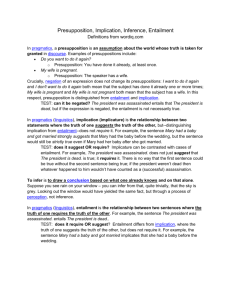

![2 Meaning[1]](http://s3.studylib.net/store/data/009749903_1-6a50d932662097cf54d6087a0fbfce74-300x300.png)
